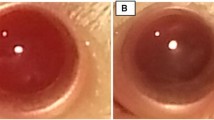Abstract
The anti-phlogistic effect of dietary vitamin E supplementation on the acute inflammation observed in experimental lens-induced uveitis in Brown Norway rats was studied. The effects of vitamin E were examined using histopathologic parameters as well as by measuring the levels of arachidonic acid metabolites. Histologic examination of the eyes revealed that the vitamin E-deficient animals had the most severe destruction of the retina, while those animals receiving the vitamin E-supplemented diet exhibited the best preservation of the retinal architecture. Levels of arachidonic acid metabolites, as determined by radioimmunoassay, were significantly higher in vitamin E deficient rats as compared with rats on a normal diet.
Similar content being viewed by others
Abbreviations
- AA:
-
arachidonic acid
- leukotriene B4 :
-
LTB4
- prostaglandin E2 :
-
PGE2
- thromboxane B2 :
-
TxB2
References
Report of the retinal and choroidal diseases panel. Vision Research, A National Plan 1983–87. U.S. Department of Health and Human Services; 1983.
Schlaegel TF Jr. Etiologic diagnosis of uveitis. In: Duane TD, Jaeger EA, editors. Clinical Ophthalmology. Philadelphia: Harper and Row; 1985; 41: 1–5.
Rao NA, Wacker WB, Marak GE Jr Experimental allergic uveitis: clinicopathologic features associated with varying doses of S antigen. Arch Ophthalmol 1979; 97: 1954–8.
Marak GE Jr Abrogation of tolerance to lens protein. In: Sears ML, editor. New Directions in Ophthalmic Research. Yale University Press, New Haven (CN): Yale University Press, 1981: 47–61.
Burton GW, Cheeseman KH, Doba T, Ingold KU, Slater TF. Vitamin E as an antioxidantin vitro andin vivo. Ciba Found Symp 1983; 101: 4–18.
Machlin L. Vitamin E and prostaglandins (PG). In: de Duve C, Hayaishi O, editors. Tocopherol, Oxygen and Biomembranes. Amsterdam: Elsevier/North-Holland, 1978: 179–89.
Tappel AL. Vitamin E as the biological lipid antioxidant. Vitam Horm 1962; 20: 493–510.
Tappel AL. Vitamin E and free radical peroxidation of lipids. Ann NY Acad Sci 1972; 203: 12–28.
Grams GW, Eskins K, Inglett GE. Dye-sensitized photooxidation of alpha tocopherol. J Am Chem Soc 1972; 94: 866–8.
Grams GW, Eskins K.. Dye-sensitized photooxidation of tocopherols. Correlation between singlet oxygen reactivity and vitamin E activity. Biochemistry 1960; 11: 606–8.
Likoff RO, Mathias MM, Nockels CF, Tengerdy RP. Vitamin E enhancement of immunity: mediated by the prostaglandins. Federation Proc 1978; 37: 829.
Likoff RO, Guptill DR, Lawrence LM, McKay CC, Mathias MM, Nockels CF, Tengerdy RP. Vitamin E and aspirin depress prostaglandins in protection of chickens againstEscherichia coli infection. Am J Clin Nutr 1981; 34: 245–51.
Mohrhauer H, Holman RT: The effect of dose level of essential fatty acids upon fatty acid composition of the rat liver. J Lipid Res 1963; 4: 151–9.
Rao NA, Fernandez MAS, Sevanian A, Till GO, Marak GE Jr. Antiphlogistic effect of catalase on experimental phacoanaphylactic endophthalmitis. Ophthalmic Res 1986; 18: 185–91.
Kirk RE. Experimental Design: Procedures for the Behavioral Sciences. Pacific Grove (CA): Brooks-Cole Publishing Company, 1982: 112–4.
Chow FI, Omaye ST. Use of antioxidants in the analysis of vitamins A and E in mammalian plasma by high performance liquid chromatography. Lipids 1983; 18: 837–41.
Lowry OH, Rosebrough NJ, Farr AL, Randall RJ. Protein measurement with the folin phenol reagent. J Biol Chem 1951; 193: 265–75.
Powell WS. Rapid extraction of arachidonic acid metabolites from biological samples using octadecylsilyl silica. Methods Enzymol 1982; 86: 467–77.
Scott M. Studies on vitamin E and related factors in nutrition and metabolism. In: Deluca H, Suttie J, editors. The Fat Soluble Vitamins. Madison (WI): University of Wisconsin Press, 1970: 355.
Fantone JC, Ward PA. Role of oxygen-derived free radicals and metabolites in leukocyte-dependent inflammatory reactions. Am J Pathol 1982; 107: 397–418.
Heinzerling RH, Tengerdy RP, Wick LL, Lueker DC. Vitamin E protects mice againstDiplococcus pneumoniae type I infection. Infect Immun 1974; 10: 1292–5.
Nockels CF. Protective effects of supplemental vitamin E against infection. Federation Proc 1979; 38: 2134–8.
Campbell PA, Cooper HR, Heinzerling RH, Tengerdy RP. Vitamin E enhancesin vitro immune response by normal and nonadherent spleen cells. Proc Soc Exp Biol Med 1974; 146: 465–9.
Author information
Authors and Affiliations
Rights and permissions
About this article
Cite this article
Cid, L., Pararajasegaram, G., Sevanian, A. et al. Anti-inflammatory effects of vitamin E on experimental lens-induced uveitis. Int Ophthalmol 16, 27–32 (1992). https://doi.org/10.1007/BF00917069
Accepted:
Issue Date:
DOI: https://doi.org/10.1007/BF00917069




